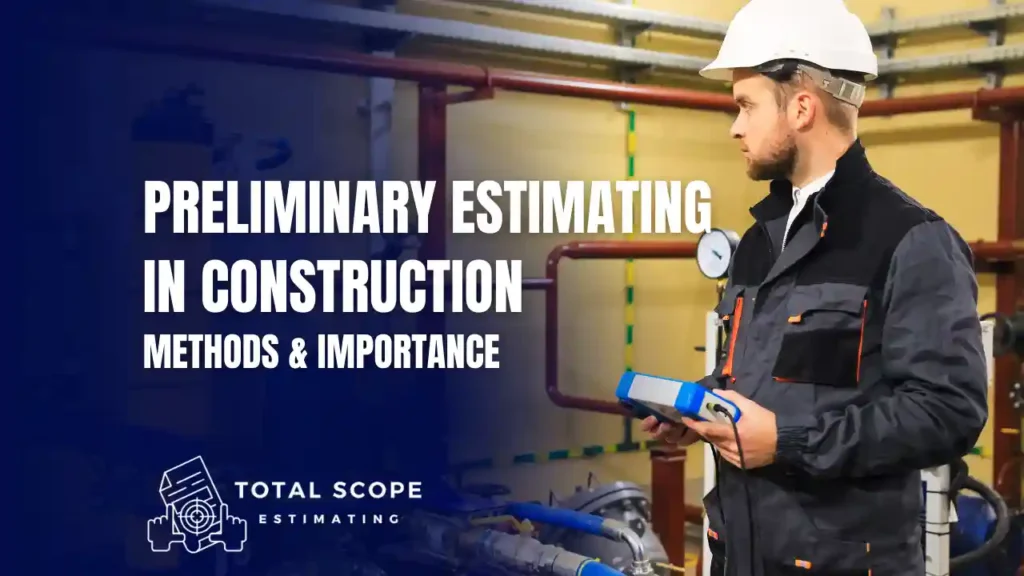An accurate estimate is the foundation of any successful construction project. Before contractors break ground or suppliers deliver materials, the estimation process begins, helping owners, architects, and contractors understand the financial scope of the project. One of the key early stages in this process is preliminary estimating, which provides a high-level overview of the expected project cost.
At Total Scope Estimating, we understand the importance of early project estimation and how it sets the tone for efficient planning and cost control. In this article, we will explore preliminary estimates, their significance, various methods, and how it can benefit project owners and contractors.
Key Takeaway:
- Preliminary estimating provides a high-level cost overview in the early stages of a construction project, based on limited information.
- It enables informed decision-making by assessing project feasibility and guiding resource allocation.
- This process helps prevent costly surprises by identifying potential issues early.
- Despite lower accuracy compared to final estimates, it sets a critical foundation for efficient planning and cost control.
What Is A Preliminary Estimate?
A preliminary estimate calculates the initial costs of a construction project. It is usually done in the early stages of construction, based on rough sketches, conceptual drawings, and rough estimates. It is traditionally based on limited information and is done in the early stages of design and construction before more detailed information is available.
Preliminary estimates are pivotal for construction projects as they determine their feasibility. They provide extensive information on the costs, materials, and resources required for the project and the time it will take to complete. They are used in various contexts, including project development, event planning, and construction.
They are not final or conclusive and keep changing as the prices update. They are critical in construction as they help contractors and business owners to make informed decisions regarding the risk assessments and feasibility studies of the construction project.
Importance Of Preliminary Estimating
Understanding the overall cost of a project at the conceptual phase helps prevent costly surprises later on. This method is particularly useful in the following situations:
Budget Allocation
Preliminary estimates help the stakeholders and construction contractors to allocate the resources appropriately. They can make more informed decisions regarding the costs, types, and quantity of materials and labor and discuss if there are any shortcomings or problems in the construction project that need to be addressed.
Feasibility Assessment
A preliminary estimating method provides a baseline for the construction project in terms of cost, material, and labor so construction contractors and business owners can better decide what is feasible for the construction project.
Design Decision
A preliminary estimates before the construction helps the contractors and construction business owners make an informed decision regarding the construction project. This can help avoid cost overruns and ensure that everything goes as planned.
Initial Approval
A rough idea or estimate before the construction boosts the efficiency of the project. This helps the stakeholders to develop strategies for reducing any potential errors and navigating the construction project to success. This ensures that nothing is left out and the project is completed on time.
Improved Communication
Estimating preliminary improves the communication between the contractors and stakeholders. Any update or change in the prices or market trends can be better communicated between various parties involved in the construction project. This helps improve the collaboration to discuss potential issues and ensure that the construction project stays on track.
At Total Scope Estimating, we offer professional preliminary estimate services to help you plan accurately from day one. If you need, contact us today.
Key Methods Of Preliminary Estimating
Several methods are used to conduct preliminary estimating. Each method has its strengths and weaknesses, depending on the level of detail and information available.
1. Analogous Estimating
This method uses the historical data acquired from old and similar construction projects to create a preliminary estimate. This method is based on the assumption that the new construction project will cost the same as the previous old construction project as they both are similar.
This method is helpful in the early stages of the construction project when not much detail is available. This rough estimate can be used to get the initial construction funding for the project. However, it can give skewed results if the project being compared doesn’t prove a perfect match. It is also less accuracy than other methods as it is based on comparisons.
2. Factor Estimating
This type of preliminary estimating, also known as “ratio estimating,” employs the method of using a single significant component of the estimate and then uses a multiplier to multiply it with the total number of elements required for the construction project. This method is often employed in large industrial projects or multiple similar projects to calculate the total amount of costs for the entire construction project.
For example, in the total cost estimation of an oil refinery, the cost of a single reactor can be used as a foundation to calculate the total costs of all the elements. This method is quite effective in construction projects where a single component dominates the entire project. However, it is not helpful for construction plans that involve multiple cost-driving factors.
3. Parametric Estimating
This method presents statistical data and mathematical equations to create a preliminary estimate. It is based on the assumption that every construction project has some connection with mathematical and statistical figures used to estimate the costs and other required resources. It offers more accuracy as compared to the other methods of preliminary estimating in construction like historical data estimating, unit cost estimating, etc.
If you want to get in detailed guide, Learn more about how to estimate construction costs using real-world techniques.
4. Historical Data Estimating
This method of preliminary estimation uses the cost calculations from a previous project, especially if the last project is similar in size, scope, or design. This method is useful for extracting costs from old projects. The estimator can get a rough estimate of how much the construction can cost by getting a reference from old and historical data.
This method serves accurate and reasonable preliminary estimates in case good historical data is available and is effective for projects of similar designs. However, any differences in the new project can affect its accuracy. It might also not reflect the exact and current market conditions.
5. Unit Cost Estimating
It is one of the most commonly used preliminary estimating methods in construction. In this method, the entire construction project is broken down into measurable elements like square foot, square lineage, feet, etc. The cost for the whole project is calculated by multiplying these units by cost per unit.
For example, you can estimate the cost of an office building by knowing the area it comprises in square feet and multiplying it by the cost per unit of the square foot. This method is easy and reliable and more helpful if you know the past cost data. However, it doesn’t take other factors into account like labor costs, equipment, availability and location, other overheads, etc.
Steps In Preliminary Estimation
Although the methods may vary, the basic steps in creating a preliminary estimate are often the same:
1. Define the Scope
The project scope and size are crucial factors to consider before making a preliminary estimate. It’s essential to clearly understand the project goals, objectives, and timeline before calculating the materials and resources required to complete the project.
2. Gather Information
Historical data from past and similar projects should be acquired to provide accurate information about the construction project. This will help give a rough idea of how much the recent construction project can cost.
3. Choose Method
Once you have gathered all the information about the construction project, it is time to choose the proper preliminary method, such as unit cost estimating, parametric estimating, analogous estimating, etc.
4. Estimate
Based on the method you chose, create an estimate for the construction project.
5. Adjust for Variables
Having complete and updated information regarding the industry standards is essential to create an accurate preliminary estimate. It can serve as a guide for getting the latest information regarding industry standards and helps gather more information about the material costs, resources, and best practices for creating a preliminary cost estimate.
6. Document Assumptions
When you have accounted for all the variables and factors in the cost estimate, also document all the constraints and restrictions that can affect the progress of the construction project.
7. Review and Refine
When you have created the estimate, review it carefully and keep updating the estimate when detailed information is available.
Comparison of Preliminary Estimating Methods
| Method | Strengths | Weaknesses |
| Analogous Estimating | Quick, useful in early stages with limited data. | Less accurate if projects aren’t closely matched. |
| Factor Estimating | Effective for projects with a dominant component. | Inaccurate for complex projects with multiple cost drivers. |
| Parametric Estimating | More accurate than analogous or historical methods. | Requires reliable data and may be complex to implement. |
| Historical Data | Accurate if good historical data is available. | Accuracy depends on project similarity and current market conditions. |
| Unit Cost Estimating | Simple, reliable with known cost data. | Ignores labor, equipment, and other overhead costs. |
Conclusion
Preliminary estimates are a strong setting stone for any construction project. It provides contractors and project managers with a rough idea of the project’s feasibility and enables them to make informed decisions timely. These may not be as accurate as the final estimates but can give a direction to the construction project.
At Total Scope Estimating, we completely understand the responsibility that comes with contractors and supervisors while creating preliminary cost estimates. If you are in the planning phase of estimates, contact us today to get professional assistance with your preliminary estimates.
Frequently Asked Questions (FAQ)
1. What is a preliminary estimate in construction?
A preliminary estimate is an initial cost calculation for a construction project, based on rough sketches and conceptual drawings, used to assess feasibility and guide planning.
2. Why is preliminary estimating important?
It helps stakeholders allocate budgets, assess project feasibility, make design decisions, gain initial approvals, and improve communication, reducing the risk of cost overruns.
3. How accurate are preliminary estimates?
Preliminary estimates are not as accurate as final estimates due to limited initial information, but they provide a reliable starting point for planning and decision-making.
4. What are the common methods of preliminary estimating?
Common methods include analogous estimating, factor estimating, parametric estimating, historical data estimating, and unit cost estimating.
5. Which method of preliminary estimating is most reliable?
Parametric estimating is often the most reliable when quality data is available. However, for simple projects, unit cost estimating is widely used.
6. When should a preliminary estimate be updated?
Preliminary estimates should be reviewed and refined as more detailed information becomes available, such as updated market conditions or project specifications.
7. Can preliminary estimates be used for final budgeting?
No, they are only for early-stage decision-making. A detailed estimate is required for final project budgeting and bidding.





